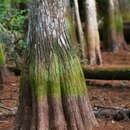fi
nimet breadcrumb-navigoinnissa


Pond cypress (Taxodium distichum var. imbricarium) is a deciduous conifer tree.It is native to the southeastern United States from Virginia to Florida and west to eastern Louisiana.Pond cypress occurs mainly in shallow ponds, lake margins, swamps, blackwater rivers and wetlands.It prefers wet, poorly drained and acidic soils, at low altitudes along the Gulf and Atlantic coastal plains.The taxonomic relationship between pond cypress and bald cypress is controversial and some literature uses the scientific name Taxodium ascendens for pond cypress; see note below.
Pond cypress trees grow to an average height of 15–18 m (49–59ft).The trunk expands at the base, anchoring the tree in the muddy soils in inhabits.When submerged or growing in waterlogged soil, the roots send up growths called “cypress knees” that rise up out of the ground or water to 1 meter (3 feet) above the roots.These woody snorkel-like structures (technically called “pneumatophores,”) help the roots to get carbon dioxide and release oxygen to the atmosphere when the waterlogged soil restricts such exchange.This makes the pond cypress very flood tolerant.
These large trees have 0.5-2 cm (0.2-0.8 inch) long needle-like leaves that grow in a spiral around the shoots. In the northern part of their range the trees lose their leaves in winter (deciduous), but further south they are evergreen.The flowers are monoecious, meaning trees produce male pollen-bearing catkins separate from the female cones.The catkins shed their pollen in early spring to fertilize the round, 2.5 cm- (1 inch-) diameter cones.One or two seeds adhere to the triangular scales that make up the cones.Cones contain up to 30 seeds.In October-December, the mature scales, or sometimes the whole cone, fall to the ground and are disseminated by animals or flood waters.New trees can grow by germination of seeds, or from shoots off the stump of a parent tree (these vegetative shoots are more viable when they sprout from young parent trees than older parents).
Pond cypress trees live for more than 1000 years.One of the largest (and presumably oldest, although its age is unknown) grew to 35 meters (106 feet) tall in Big Tree Park, Florida before it was burned down in 2012.
Pond cypress trees are the dominant trees in cypress dome swamps (the most common type of swamp in Florida).These woody wetland ecosystems form in stagnant, acidic water-filled depressions along the Gulf Coast and Southern Atlantic plains. They are “dome shaped” because the trees in the middle of the depression grow more vigorously than those around the outside.Cypress dome swamps harbor a diversity of vegetation as well as fauna, including many threatened and endangered species.
Pond cypress trees are a valuable timber tree.Their wood contains a chemical called cypressene that acts as a natural preservative and very resistant to rot and termites.Older trees accumulate more cypressene and are more resistant than second-growth trees. The "knees" are frequently used for curved pieces in the construction of wooden boats.Pond cypress was one of the first New World species brought back to England (in 1637).
NOTE: taxonomically, pond cypress (Taxodium distichum var. imbricarium) and bald cypress (T. distichum var. distichum) are classified as two varieties of the species distichum rather than as a distinct species in their own right, since they overlap in their geographical distribution and hybridize with each other.However bald and pond cypress are ecologically distinct, and for this reason some recognize these taxa with species level distinction: T. ascendens (pond cypress) and T. distichum (bald cypress). In popular use the variety is often named "imbricarium" rather than "imbricatum."
(Earle, 2015; NatureServe 2015; Wikipedia 8 December 2015 a,b,c)